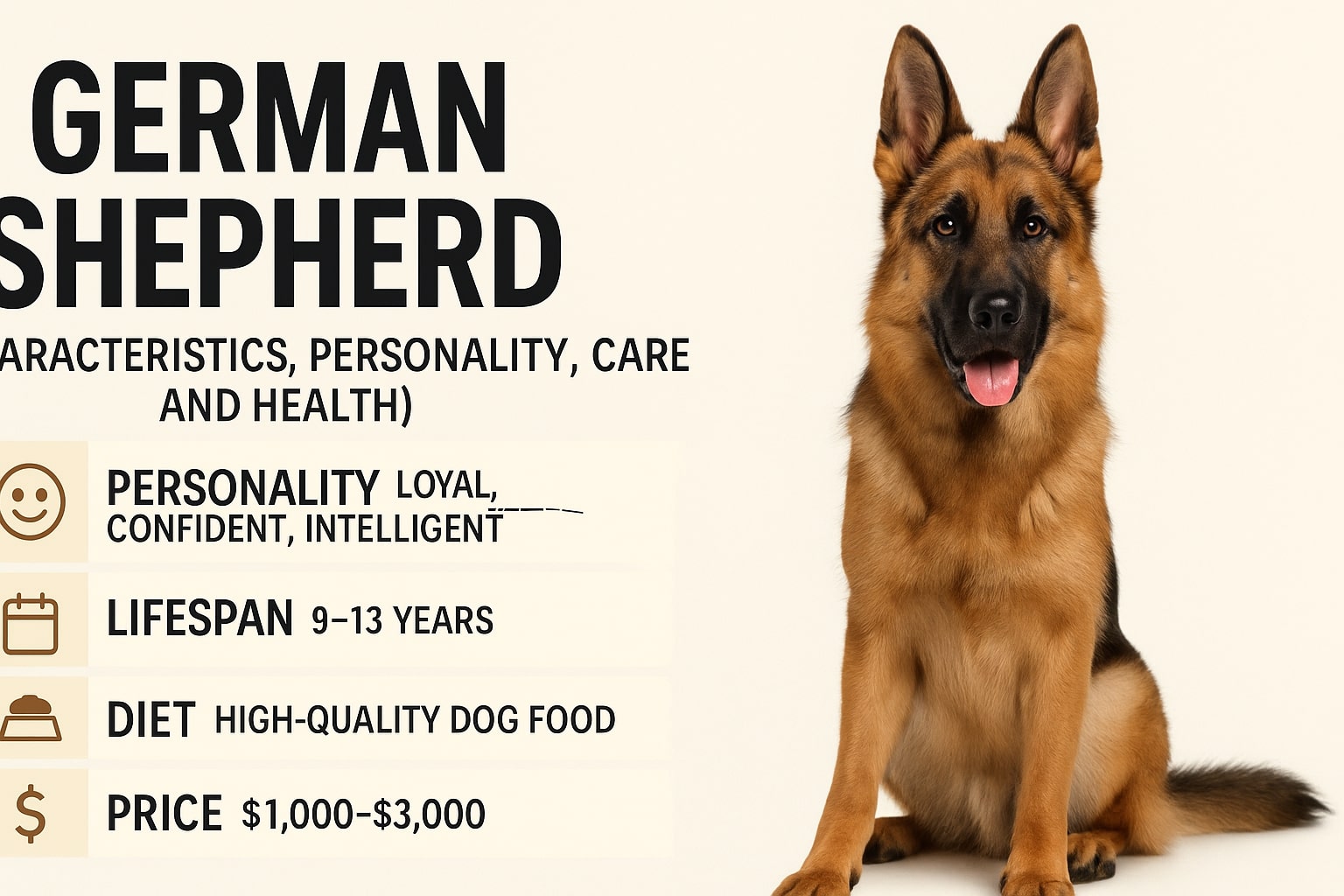The German Shepherd stands as one of the most recognizable and beloved dog breeds worldwide, capturing hearts with their striking appearance, remarkable intelligence, and unwavering loyalty.
Whether you have seen them starring in Hollywood movies, working alongside police officers, or serving as devoted family companions, German Shepherds have earned their reputation as truly exceptional dogs.
This comprehensive guide explores everything you need to know about this magnificent breed, from their fascinating origins to their modern-day roles as both working dogs and cherished family members.
The Rich History Behind the Breed
The story of the German Shepherd begins in late 19th century Germany with a visionary man named Captain Max von Stephanitz, who is widely recognized as the father of the German Shepherd breed1. Von Stephanitz had a clear goal in mind: he wanted to create a dog breed that would excel in herding and guarding sheep while combining remarkable strength, intelligence, and an exceptional sense of smell.
The pivotal moment came in 1899 when von Stephanitz encountered a dog named Hektor Linksrhein at a dog show. Impressed by Hektor’s intelligence and outstanding physical attributes, von Stephanitz immediately purchased the dog, renamed him Horand von Grafrath, and declared him the first official German Shepherd.
This single dog became the cornerstone of the entire breed, and von Stephanitz founded the Verein für Deutsche Schäferhunde (Society for the German Shepherd Dog) to carefully oversee the breed’s development.
Under von Stephanitz’s careful guidance, the German Shepherd breed underwent standardization, with a specific focus on traits that would make these dogs excellent working animals. The breed’s remarkable versatility quickly became apparent as German Shepherds proved themselves capable not only in herding but also in various other roles, including police work, search and rescue operations, and as service animals.
The breed’s popularity began spreading beyond Germany’s borders, particularly after World War I, when returning soldiers shared captivating stories of German Shepherds’ bravery and exceptional utility in wartime situations. Two famous German Shepherds, Rin Tin Tin and Strongheart, who became Hollywood stars, further cemented the breed’s popularity throughout the United States and around the world.
Physical Characteristics and Breed Standards
The American Kennel Club (AKC) has established specific breed standards that define what makes a German Shepherd truly exceptional. According to these standards, German Shepherds should be overall strong, agile, well-muscled, and full of life. Their body structure is longer than tall, with a deep-bodied frame and an outline of smooth, flowing curves.
Size specifications are quite specific: males typically stand 24 to 26 inches tall at the shoulders, while females measure 22 to 24 inches. The head should be noble, strong, and chiseled, featuring a long muzzle that runs parallel to the back of the skull. Their eyes are characteristically almond-shaped and never protruding, giving them an alert and intelligent expression.
One of the most distinctive features of German Shepherds is their moderately pointed ears that face forward and are set parallel to one another. The nose is typically black, though blue or liver colors sometimes occur but are considered faults in show dogs. German Shepherds have a scissors bite, meaning their teeth meet in a strong, precise alignment.
The body structure includes shoulders that are higher than the back, which remains level and straight. The sternum reaches to the elbows with a moderately tucked-up loin. Their tail is notably bushy, set low, and hangs in a slight curve. The shoulder blades are obliquely angled with well-angulated wrists, while the thighs are broad with a right angle between the upper and lower thigh.
German Shepherds possess a distinctive double coat of medium length, featuring a dense, straight, and harsh outer coat. Most colors are permitted except for white, though rich colors are preferred in show standards. Their gait is particularly noteworthy, being ground-covering and effortless, allowing them to work for extended periods without fatigue.
Temperament and Personality Traits
The German Shepherd’s temperament is perhaps what sets them apart most dramatically from other breeds. According to breed standards, their temperament should be confident, fearless but aloof, eager, alert, and willing to work. This combination of traits makes them exceptional both as working dogs and family companions.
Von Stephanitz himself described the most striking features of correctly bred German Shepherds as “firmness of nerves, attentiveness, tractability, watchfulness, reliability, and incorruptibility together with courage, fighting tenacity and harness”. The alpha-like personality of a German Shepherd should be confident yet not self-indulgent.
German Shepherds are naturally confident and aloof, exhibiting the temperament of a trained fighter. They remain calm and assertive, aware of their capabilities, and only become excitable when situations call them to action. This controlled energy stems from their herding dog heritage, which gives them quite a strong prey drive.
This prey drive is particularly noticeable during their youth, as their desire for mental stimulation and interactive games makes them extremely active and energetic. Young German Shepherds require considerable time and attention from their owners, as absent owners can lead to their well-rounded temperaments going awry. However, these are naturally docile and obedient creatures whose willingness to learn often overpowers their early enthusiasm.
The breed has maintained its position in the top five most popular dog breeds since their emergence in the late 19th century and has never seen a decline in popularity. This sustained popularity stems from their unrivaled excellence across multiple areas of canine performance.
Training and Intelligence
German Shepherds are widely regarded as one of the most intelligent, versatile, and trainable dog breeds in the world. Their exceptional intelligence, combined with their eagerness to learn, makes them ideal candidates for various types of training, from basic obedience to advanced K9 work.
These dogs have a strong work ethic and require both mental and physical stimulation to thrive properly. Without adequate training, German Shepherds can develop problematic behaviors such as excessive barking, destructive chewing, and even aggression. Their high intelligence means they quickly grasp new commands, but this same intelligence requires consistent training and structure to keep them properly engaged.
Training should begin early in puppyhood and continue throughout their lives to reinforce good behavior and develop their skills. Before moving to advanced training or specialized K9 work, every German Shepherd must master basic obedience commands.
Essential commands include “sit and stay,” which provide a foundation for self-control and discipline while helping prevent unwanted behaviors such as jumping on guests or running into dangerous situations. The “come when called” command is vital for keeping dogs safe, ensuring they return in potentially dangerous situations near traffic or other animals. Leash training and the “heel” command prevent pulling and make walks more enjoyable for both dog and owner.
Their natural intelligence and eagerness to please make German Shepherds excel in obedience training, protection work, and specialized K9 training programs. Whether being trained as family companions, working dogs, or law enforcement K9s, proper training remains absolutely essential for this breed.
Health Considerations and Common Issues
Like all dog breeds, German Shepherds are prone to certain health issues that potential owners should understand and prepare for. One of the most common health concerns affecting German Shepherds is hip dysplasia, a genetic condition that affects the hip joints and can lead to pain, lameness, and arthritis. Veterinary specialists emphasize that hip dysplasia is a common concern for German Shepherds due to their genetics, making it important for owners to be proactive in managing this condition through proper exercise, weight management, and regular veterinary check-ups.
Another significant health trend affecting German Shepherds is the rising incidence of degenerative myelopathy, a progressive neurological disease that affects the spinal cord. Veterinary neurologists explain that degenerative myelopathy is becoming more prevalent in German Shepherds, likely due to a combination of genetic and environmental factors. Early detection and proper management are key factors in slowing the progression of this serious disease.
German Shepherds are also prone to bloat, a life-threatening condition where the stomach fills with gas and twists on itself. Veterinary surgeons warn that bloat can occur suddenly and requires immediate veterinary attention. Owners should be aware of bloat symptoms, including restlessness, pacing, and a distended abdomen, and seek emergency help immediately if they suspect their dog is affected.
Beyond these major concerns, German Shepherds are at risk for various other health issues that responsible owners should monitor. Regular veterinary check-ups, proper nutrition, appropriate exercise, and maintaining healthy weight are crucial factors in keeping German Shepherds healthy throughout their lives.
Living with a German Shepherd
Bringing a German Shepherd into your home represents a significant commitment that extends far beyond basic pet ownership. These remarkable dogs thrive in environments where they receive adequate mental stimulation, physical exercise, and consistent training. Their intelligence and energy levels mean they require owners who can dedicate time to their development and well-being.
German Shepherds form incredibly strong bonds with their families and often become protective of their household members. This protective instinct, while admirable, requires proper socialization from an early age to ensure they can distinguish between genuine threats and normal social situations. Early socialization helps prevent overprotective behaviors that might interfere with normal family activities or social interactions.
Exercise requirements for German Shepherds are substantial. These dogs were bred for work and maintain high energy levels throughout their lives. Daily walks alone are insufficient; they need vigorous exercise, mental challenges, and opportunities to engage their natural instincts. Activities like hiking, running, agility training, or even specialized dog sports can help meet their exercise needs while strengthening the bond between dog and owner.
The grooming needs of German Shepherds are moderate but consistent. Their double coat requires regular brushing to manage shedding and prevent matting. During shedding seasons, which typically occur twice yearly, daily brushing becomes essential to manage the increased hair loss.
German Shepherds adapt well to various living situations, from apartments to large homes with yards, provided their exercise and mental stimulation needs are met. However, they do best in homes where they have space to move freely and families who understand their need for structure and consistency.
Conclusion
The German Shepherd represents one of the most remarkable achievements in dog breeding, combining intelligence, loyalty, versatility, and beauty in a single breed. From their carefully planned origins in 19th century Germany to their current status as beloved family companions and essential working dogs, German Shepherds have consistently proven their exceptional value to human society.
Whether serving in law enforcement, working as service animals, competing in dog sports, or simply providing devoted companionship to families, German Shepherds excel in whatever role they’re given. Their intelligence and trainability make them suitable for experienced dog owners who can provide the structure, exercise, and mental stimulation these remarkable dogs require.
For those considering adding a German Shepherd to their family, understanding the breed’s needs, potential health concerns, and training requirements is essential. With proper care, training, and commitment, a German Shepherd can become not just a pet but a truly exceptional companion who will enrich your life in countless ways.
Their legacy as one of the world’s most capable and beloved dog breeds continues to grow, ensuring that German Shepherds will remain treasured companions for generations to come.
- 9 Types of Lovebirds (A Comprehensive Guide for Pet Bird Owners) - June 20, 2025
- Labrador Retriever: America’s Most Beloved Family Dog - June 9, 2025
- The Complete Guide to Indian Ringneck Parrots - June 9, 2025















